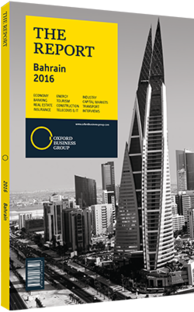Bahraini government boosts public spending to spur growth
Ramped-up investment programmes and solid private sector expansion helped sustain Bahrain’s economic growth in 2015, albeit at a slower pace than in previous years. According to the IMF, the final figure for GDP growth in 2015 is expected to be 3.2%. While down on the 4.5% growth recorded in 2014, this places Bahrain’s economy ahead of the MENA average of 2.3% and the global average of 3.1%. Growth is forecast to remain stable in 2016, predicted to come in at 3.2%, according to IMF estimates.
Energy Impact
The more modest performance of 2015 was largely down to lower oil prices, which have eroded Bahrain’s export earnings and government revenues. While not a major producer in global terms, Bahrain continues to export processed oil products, sourcing crude from both its own relatively small reserves and the Abu Saafa field that it shares with neighbouring Saudi Arabia.
The oil and gas industry typically accounts for around 85% of government revenue, though the sector’s share of GDP has fallen to 20% – down from more than 40% in 2000 – due in part to the government’s strong push for economic diversification.
According to the Bahrain Economic Development Board (EDB), the non-oil economy recorded 4.2% growth in the first nine months of 2015. This has had positive carry-through effects on unemployment in particular, which shrank to 3.1% in the third quarter – its lowest level in years, as per figures from the Ministry of Labour and Social Development.
Financing Obstacles
Declining oil revenues have nonetheless had a major impact on the state’s fiscal position, with the 2015 budgetary cycle expected to close with a deficit of 12.5% of GDP, according to ratings agency Fitch, up from a 5% shortfall in 2014.
The government has looked primarily to financial markets to bridge the gap, having issued a dual-tranche offer worth $1.5bn in early November. The five- and 10-year bonds, which offer coupon rates of 5.875% and 7%, respectively, were oversubscribed at $2.4bn, according to media reports.
Cutting Costs, Rising Prices
The government has taken steps to curb spending through a gradual scaling back on costly fuel, food and utility subsidies, currently valued at around $2bn per year. In April 2015 Bahrain raised the subsidised price of gas for industrial customers. This was followed by the trimming of support for food products such as meat and chicken in October, causing prices to more than double.
However, as citizens are set to receive cash transfers to compensate for rising food prices, foreigners will likely bear the brunt of higher costs. Plans are also reportedly in the works to increase water and electricity tariffs for large companies and expatriates.
Inflation rose to 2.3% year-on-year in October 2015 after flattening mid-year, driven by higher food costs. By November, however, inflation had eased to 1.5%. While inflation remains moderate, the Central Bank of Bahrain raised its overnight rate by 25 basis points to 0.5% in mid-December.
Investment Boost
The government also rolled out plans to boost public investment in 2015. While seemingly at odds with efforts to trim expenditures, spending aimed at improving import and processing capacity in the energy sector, alongside guaranteed spending on large infrastructure projects funded by the Gulf Development Programme, is expected to help fuel private sector growth. According to the EDB’s “Bahrain Economic Quarterly” report from December 2015, nearly $6bn worth of projects had been allocated under the fund.
Non-energy infrastructure projects unveiled during 2015 included an $815m upgrade to Bahrain International Airport; more than $300m worth of road development schemes, to be funded by the Kuwait Fund for Arab Economic Development; and a $1bn public-private partnership project for the construction of more than 3000 social housing units.
You have reached the limit of premium articles you can view for free.
Choose from the options below to purchase print or digital editions of our Reports. You can also purchase a website subscription giving you unlimited access to all of our Reports online for 12 months.
If you have already purchased this Report or have a website subscription, please login to continue.

